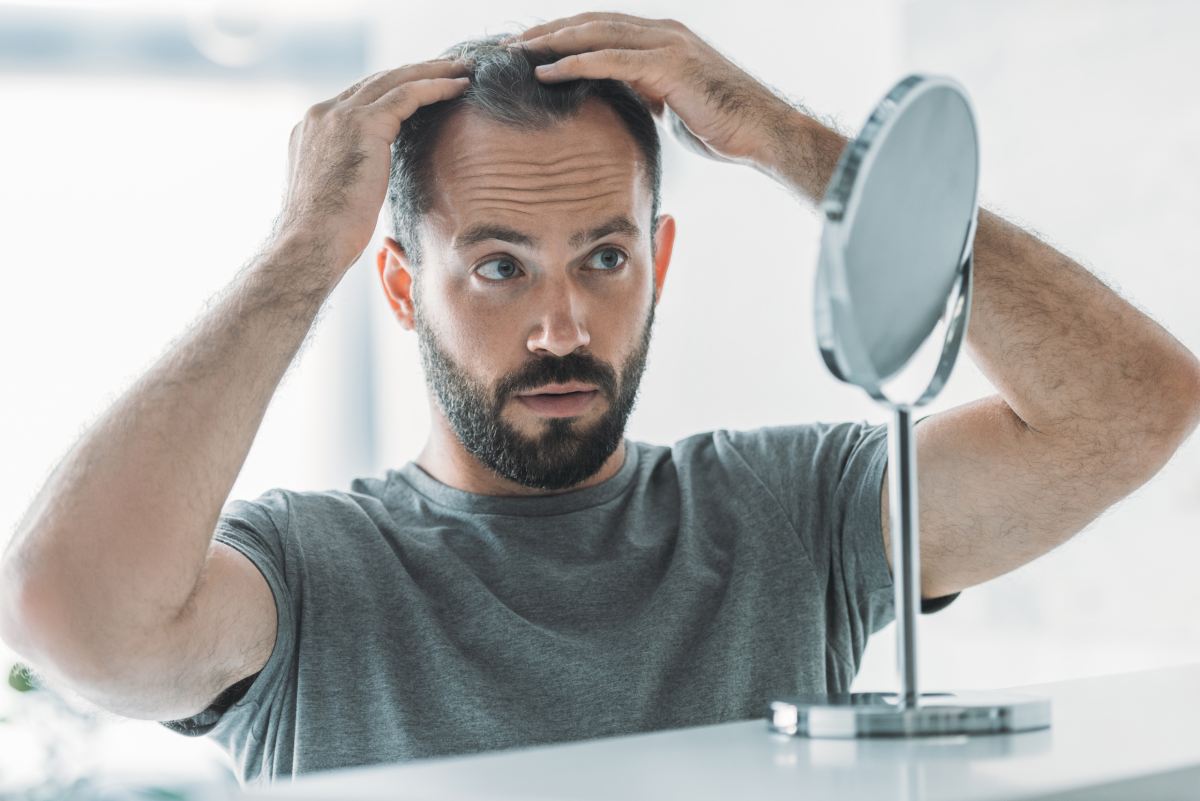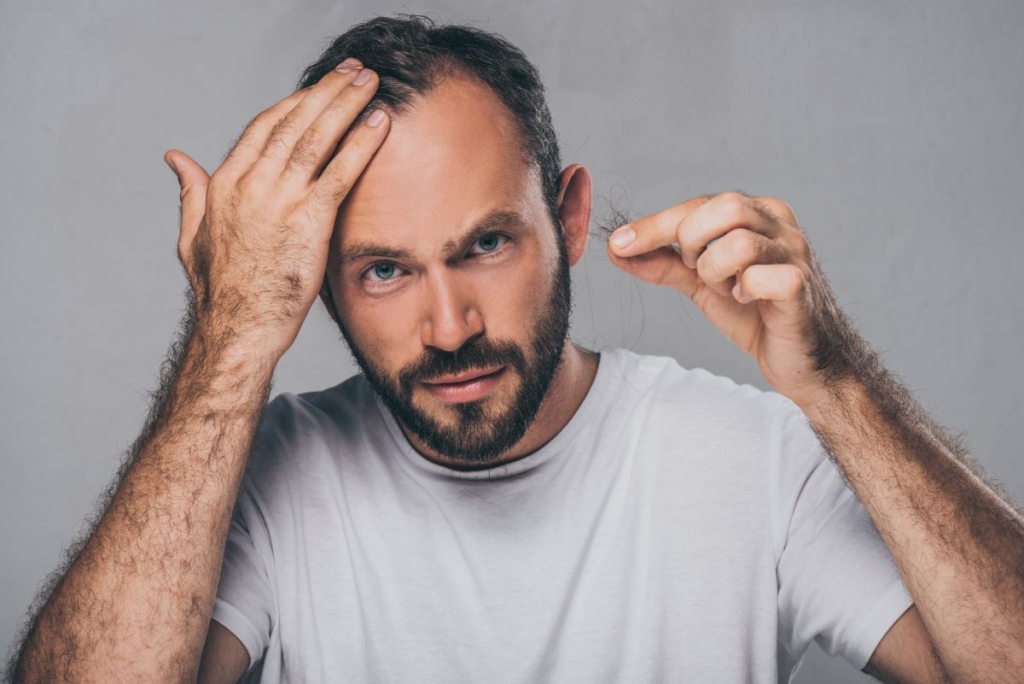
A widow’s peak is one of the most distinctive hairline shapes. For some, it’s simply a genetic trait that adds character to their appearance. For others, especially when accompanied by thinning or temple recession, it raises concerns about whether it signals the start of balding.
The truth is that a widow’s peak can either be a completely natural feature or a sign of progressive hair loss, depending on its cause. Knowing the difference is essential for understanding whether it requires treatment or is simply part of your natural look.
This article explores what a widow’s peak really is, the factors that cause it, and how to distinguish it from a receding hairline. Most importantly, we’ll look at how a hair transplant can reshape, restore, or enhance this area for those who want a fuller, more balanced hairline.
What Is a Widow’s Peak?
A widow’s peak is a distinctive V-shaped point that appears in the middle of the hairline, creating a dip in the center of the forehead. While many people have straight or rounded hairlines, a widow’s peak stands out because of its sharper, more triangular contour.
The name comes from a centuries-old tradition in which widows would wear a pointed hood or headdress, symbolizing mourning. Over time, the term came to describe this naturally pointed hairline shape.
It’s important to remember that a widow’s peak by itself is not a medical condition or a guaranteed sign of future hair loss. For many, it remains a stable and natural part of their appearance throughout life. For others, however, changes in the widow’s peak area may signal hairline maturation or the early stages of a receding hairline; a distinction we’ll explore in the next sections.
For many patients, a widow’s peak exaggerated by temple thinning is actually an early sign of androgenetic alopecia. To better understand the condition behind this, see our guide on Male Pattern Baldness: What Is the Cause of Male Pattern Baldness?.
What Causes Widow’s Peak Hair?
Not all widow’s peaks are the same, and the reasons behind them vary. For some, it’s simply an inherited trait that never changes, while for others it’s connected to gradual hairline recession. The main causes include:
Genetics
A widow’s peak is often passed down through family lines. If your parents or grandparents have one, there’s a good chance you will too. In these cases, the V-shape appears early in life and usually stays stable without significant thinning.
Hairline Maturation
As teenagers transition into adulthood, the juvenile hairline naturally rises by 1–2 cm, creating a slightly more defined, sometimes pointed shape. This stage is normal and does not necessarily mean balding is occurring.
Pattern Hair Loss
In many men, and some women, androgenetic alopecia (commonly known as male or female pattern baldness) can exaggerate or create a widow’s peak. Hair at the temples becomes thinner and recedes, leaving a pronounced point in the middle of the forehead. Unlike a stable genetic widow’s peak, this type progresses over time.
Other Factors
Although rare, certain medical or developmental conditions can influence hairline shape. In most cases, however, widow’s peak is either hereditary or related to common hairline changes.
Widow’s Peak vs Receding Hairline
At first glance, a widow’s peak and a receding hairline can look similar as both of them involve a V-shape at the front of the forehead. However, they have very different causes and implications for long-term hair density. Perceiving the differences can help you decide whether you simply have a unique hairline shape or are seeing the early signs of balding.
| Feature | Widow’s Peak | Receding Hairline |
|---|---|---|
| Cause | Genetic trait or natural hairline maturation | Androgenetic alopecia (pattern hair loss) |
| Age of Onset | Can appear in childhood or teenage years | Often starts in late teens to 30s |
| Progression | Usually stable over time | Gradually worsens without treatment |
| Shape | Central V-shape with even density around it | M-shaped hairline with temple recession |
| Hair Density | Thick and consistent across the scalp | Noticeable thinning, miniaturized hairs at temples |
| Treatment Need | None, unless for cosmetic adjustment | May benefit from treatments or transplant |
A true widow’s peak may not require medical attention. But when the V-shape is the result of hair loss, especially at the temples, early treatment can help preserve density and prevent further recession. That’s why recognizing whether your hairline is stable or receding is key to deciding next steps. You can read our article titled Understanding the Different Types of Alopecia to see how widow’s peak–like patterns fit into broader hair loss conditions.
Self-Assessment Tips to Tell Them Apart

If you’re unsure whether your hairline is a natural widow’s peak or an early receding hairline, you can use these simple self-check steps at home. While not a substitute for professional diagnosis, they help you notice important differences:
- Compare with Old Photos: Look at pictures of yourself from a few years ago. If your hairline point looks the same, it’s likely a widow’s peak. If the temples look deeper over time, it may be a recession.
- Check Hair Density at the Temples: Run your fingers through the temple area just behind the hairline. Full thickness suggests a widow’s peak, while thinning or finer hairs indicate hairline recession.
- Look at the Overall Shape: A widow’s peak creates a central point with even density around it. A receding hairline typically forms an M-shape, with temple areas pulling back unevenly.
- Monitor Changes Over Time: A widow’s peak stays stable for years. If your hairline continues to move back within months or a couple of years, it’s more likely to be a recession.
- Consider Family History: If male or female pattern baldness runs in your family, and you notice temple thinning, your widow’s peak may be linked to hair loss rather than genetics alone.
If you’re noticing changes and wondering whether it’s time to act, our article 5 Signs You Are Ready for a Hair Transplant can help you evaluate your situation more clearly.
Can a Widow’s Peak Change Over Time?
A natural widow’s peak that appears due to genetics or hairline maturation usually stays the same throughout adulthood. The shape may look slightly different as your face matures, but the density and position of the peak remain stable.
However, if the V-shape becomes sharper because the temples are thinning, that’s no longer just a widow’s peak but a receding hairline. In other words, the peak itself doesn’t “move,” but the surrounding areas can change if hair loss begins.
Key points to keep in mind:
- Stable widow’s peak: Remains consistent for decades without significant thinning.
- Receding widow’s peak: Often develops when androgenetic alopecia progresses, exaggerating the V-shape.
- Monitoring matters: If you notice rapid change in density or shape, consult a specialist to rule out pattern hair loss.
Can You Fix a Widow’s Peak with a Hair Transplant?

A widow’s peak isn’t a problem in itself, but many people want to change its appearance either for aesthetic preference or because hair loss has made it look more pronounced. A hair transplant is the only permanent way to reshape or restore a widow’s peak, but the approach depends on the patient’s needs.
When Treatment Is Cosmetic
Some patients are happy with their overall density but simply don’t like the sharp V-shape of their natural hairline. In these cases, treatment is purely aesthetic:
- Rounding out the peak: Follicles can be transplanted around the central point to create a straighter or softer curve.
- Customizing the shape: Surgeons design a hairline that better fits facial balance, whether slightly straighter or more gently rounded.
- Permanent change: Unlike styling tricks or temporary treatments, transplanted follicles continue to grow naturally for life.
When Treatment Is Restorative
In other cases, the widow’s peak has become exaggerated because of thinning or balding at the temples. Here, the focus is on restoring what’s been lost:
- Temple restoration: Grafts are placed in the receding temple zones to reduce the depth of the M-shape.
- Blending with existing hair: Transplanted follicles are matched in direction and density to blend seamlessly with your peak.
- Rebuilding balance: The aim is to restore symmetry, so the widow’s peak looks natural rather than overly sharp.
Techniques Used for Widow’s Peak Hair Transplants
The choice of technique affects not only the density but also the natural look of the new hairline. Surgeons in Turkey often use one of the following methods:
- FUE (Follicular Unit Extraction): The most widely used method, involving the extraction of individual follicular units for precise placement.
- Sapphire FUE: A refinement of FUE that uses sapphire blades to create ultra-fine channels, allowing denser packing and faster healing.
- DHI (Direct Hair Implantation): Ideal for detailed hairline work, as implanter pens give surgeons maximum control over the direction and angle of each graft.
Patients also benefit from clear recovery expectations, as outlined in our detailed guide Hair Transplant Timeline: A Guide to Hair Transplant Recovery & Growth Chart.
Considerations for Natural Design
Hairline design is just as important as the transplant itself. Without careful planning, results can look unnatural. That’s why surgeons take into account:
- Age and long-term progression: A hairline that looks “too low” may not suit you later in life.
- Facial proportions: The new design must match your bone structure, forehead height, and natural symmetry.
- Hair characteristics: Thickness, curl, and color contrast are all factored in to achieve a seamless look.
Long-term planning is critical here, since your results should evolve naturally with age. To see how design, technique, and graft use all come together, check out Hair Transplant Success: The Key Elements Behind a Great Result.
Cosmetic vs. Restorative: Which One Fits You?
- If your widow’s peak has always been sharp but your hair is otherwise full and dense: You’re likely considering a cosmetic adjustment. A transplant here focuses on rounding or softening the hairline for balance.
- If your widow’s peak has deepened over time because your temples are thinning or receding: You’re a candidate for a restorative approach, where grafts are used to rebuild lost density and reshape the frontal hairline.
- If you’re unsure whether it’s natural or due to hair loss: A professional evaluation can determine whether your hairline is simply “maturing” or whether it’s the start of male pattern baldness.
Hair Transplant in Turkey for Widow’s Peak and Receding Hairline with MCAN Health
Whether your widow’s peak feels too pronounced or you’ve noticed it becoming sharper due to temple recession, the right intervention can restore balance to your hairline and confidence to your appearance. At MCAN Health, we go beyond simply adding grafts. Our goal is to design a hairline that looks natural, suits your facial proportions, and lasts for years to come.
When you choose MCAN Health for your hair transplant in Turkey, you benefit from:
- Expert hairline artistry: Every design takes into account your age, features, and natural growth pattern, ensuring results that look authentic.
- Modern surgical methods: Advanced FUE, Sapphire FUE, and DHI techniques allow for precise placement and high graft survival in both cosmetic and restorative cases.
- Tailored patient care: Our all-inclusive packages cover everything from airport transfers and accommodation to post-operative support, giving you peace of mind throughout the journey.
- Long-term focus: We emphasize ethical graft use, donor area preservation, and realistic planning so your results remain stable as you age.
At MCAN Health, we bring together Turkey’s global expertise in hair restoration with a patient-first approach. Whether you want to soften a natural widow’s peak or address a receding hairline, our team is dedicated to achieving results that restore harmony to your hairline and confidence to your everyday life.
 Do I Need a Breast Implants Replacement? How Often?
Do I Need a Breast Implants Replacement? How Often?  Smoking After Hair Transplant Can Affect the Healing Procedure and Result
Smoking After Hair Transplant Can Affect the Healing Procedure and Result  MCAN Medical Aesthetic Clinic is Awarded as The Best Aesthetic Clinic of Turkey!
MCAN Medical Aesthetic Clinic is Awarded as The Best Aesthetic Clinic of Turkey!